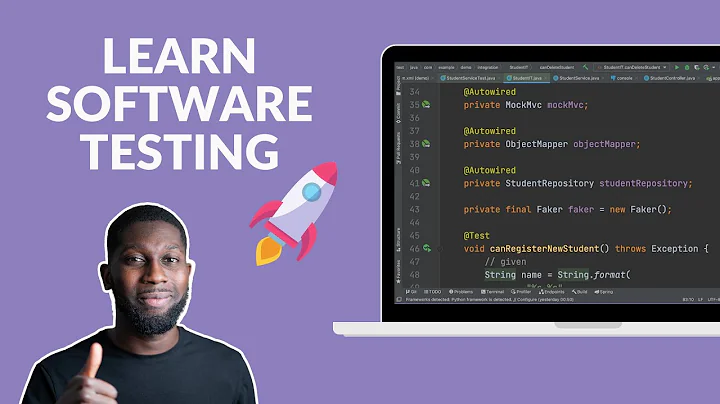How to write integration tests with spring-cloud-netflix and feign
Solution 1
Use Spring's RestTemplate instead of feign. RestTemplate is also able to resolve service names via eureka, so you can do something like this:
@Component
public class SomeService {
@Autowired
RestTemplate restTemplate;
public String doSomething() {
try {
restTemplate.postForEntity("http://my-service/some/url",
new BazzleRequest(...),
Void.class);
return "so bazzle my eyes dazzle";
} catch(HttpStatusCodeException e) {
return "Not bazzle today!";
}
}
}
This is way easier testable with Wiremock than feign.
Solution 2
Here is an example of using WireMock to test SpringBoot configuration with Feign client and Hystrix fallback.
If you are using Eureka as a server discovery, you need to disable it by setting a property "eureka.client.enabled=false".
First, we need to enable the Feign/Hystrix configuration for our application:
@SpringBootApplication
@EnableFeignClients
@EnableCircuitBreaker
public class Application {
public static void main(String[] args) {
SpringApplication.run(Application.class, args);
}
}
@FeignClient(
name = "bookstore-server",
fallback = BookClientFallback.class,
qualifier = "bookClient"
)
public interface BookClient {
@RequestMapping(method = RequestMethod.GET, path = "/book/{id}")
Book findById(@PathVariable("id") String id);
}
@Component
public class BookClientFallback implements BookClient {
@Override
public Book findById(String id) {
return Book.builder().id("fallback-id").title("default").isbn("default").build();
}
}
Please note that we are specifying a fallback class for the Feign client. Fallback class will be called every time Feign client call fails (e.g. connection timeout).
In order for tests to work, we need to configure the Ribbon loadbalancer (will be used internally by Feign client when sending http request):
@RunWith(SpringRunner.class)
@SpringBootTest(properties = {
"feign.hystrix.enabled=true"
})
@ContextConfiguration(classes = {BookClientTest.LocalRibbonClientConfiguration.class})
public class BookClientTest {
@Autowired
public BookClient bookClient;
@ClassRule
public static WireMockClassRule wiremock = new WireMockClassRule(
wireMockConfig().dynamicPort()));
@Before
public void setup() throws IOException {
stubFor(get(urlEqualTo("/book/12345"))
.willReturn(aResponse()
.withStatus(HttpStatus.OK.value())
.withHeader("Content-Type", MediaType.APPLICATION_JSON)
.withBody(StreamUtils.copyToString(getClass().getClassLoader().getResourceAsStream("fixtures/book.json"), Charset.defaultCharset()))));
}
@Test
public void testFindById() {
Book result = bookClient.findById("12345");
assertNotNull("should not be null", result);
assertThat(result.getId(), is("12345"));
}
@Test
public void testFindByIdFallback() {
stubFor(get(urlEqualTo("/book/12345"))
.willReturn(aResponse().withFixedDelay(60000)));
Book result = bookClient.findById("12345");
assertNotNull("should not be null", result);
assertThat(result.getId(), is("fallback-id"));
}
@TestConfiguration
public static class LocalRibbonClientConfiguration {
@Bean
public ServerList<Server> ribbonServerList() {
return new StaticServerList<>(new Server("localhost", wiremock.port()));
}
}
}
Ribbon server list need to match the url (host and port) of our WireMock configuration.
Solution 3
Here is an example how to do the wiring of Feign and WireMock with random port (based on Spring-Boot github answer).
@RunWith(SpringRunner.class)
@SpringBootTest(properties = "google.url=http://google.com") // emulate application.properties
@ContextConfiguration(initializers = PortTest.RandomPortInitializer.class)
@EnableFeignClients(clients = PortTest.Google.class)
public class PortTest {
@ClassRule
public static WireMockClassRule wireMockRule = new WireMockClassRule(
wireMockConfig().dynamicPort()
);
@FeignClient(name = "google", url = "${google.url}")
public interface Google {
@RequestMapping(method = RequestMethod.GET, value = "/")
String request();
}
@Autowired
public Google google;
@Test
public void testName() throws Exception {
stubFor(get(urlEqualTo("/"))
.willReturn(aResponse()
.withStatus(HttpStatus.OK.value())
.withBody("Hello")));
assertEquals("Hello", google.request());
}
public static class RandomPortInitializer implements ApplicationContextInitializer<ConfigurableApplicationContext> {
@Override
public void initialize(ConfigurableApplicationContext applicationContext) {
// If the next statement is commented out,
// Feign will go to google.com instead of localhost
TestPropertySourceUtils
.addInlinedPropertiesToEnvironment(applicationContext,
"google.url=" + "http://localhost:" + wireMockRule.port()
);
}
}
}
Alternatively you can try playing with System.setProperty() in @BeforeClass method of your test.
Solution 4
There used to be basically two options for doing integration tests for microservices applications:
- Deployment of services to a test environment and make end-to-end tests
- Mocking other microservices
First option has the obvious disadvantage of the hassle of deploying all the dependencies (other services, databases, etc) as well. In addition, it is slow and hard to debug.
Second option is faster and has less hassle but it is easy to end up with stubs that behave differently than the reality in time, due to possible code changes. So it is possible to have successful tests but failing app when deployed to prod.
A better solution would be using consumer driven contract verification, so that you will make sure that provider service's API is compliant with the consumer calls. For this purpose, Spring developers can use Spring Cloud Contract. For other environments, there is a framework called PACT. Both can be used with Feign clients as well. Here is an example with PACT.
Solution 5
I personally prefer mockServer to stub any restful API, it is easy to use and is similar to wiremock, but is very powerful compared to the latter.
I have attached the sample code written with groovy/spock for stubbing a GET restful call with mockServer.
First autowire the mockServer instance in test class
@Autowired
private static ClientAndServer mockServer
start the mockServer instance from the setupSpec() method, this method is similar to junit method annotated with @BeforeClass.
def setupSpec() {
mockServer = ClientAndServer.startClientAndServer(8080)
}
define the required stub in the corresponding unit test
def "test case"() {
given:
new MockServerClient("localhost",8080).when(HttpRequest.request().withMethod("GET").withPath("/test/api").withQueryStringParameters(Parameter.param("param1", "param1_value"), Parameter.param("param2", "param2_value"))).respond(HttpResponse.response().withStatusCode(HttpStatus.OK.value()).withBody("{ message: 'sample response' }"))
when:
//your code
then:
//your code
}
after the execution of test cases, stop the mock server
def cleanupSpec() {
mockServer.stop()
}
Related videos on Youtube
Bastian Voigt
Bastian Voigt, Freelance Software Developer and IT Project Manager
Updated on July 09, 2022Comments
-
 Bastian Voigt almost 2 years
Bastian Voigt almost 2 yearsI use Spring-Cloud-Netflix for communication between micro services. Let's say I have two services, Foo and Bar, and Foo consumes one of Bar's REST endpoints. I use an interface annotated with
@FeignClient:@FeignClient public interface BarClient { @RequestMapping(value = "/some/url", method = "POST") void bazzle(@RequestBody BazzleRequest); }Then I have a service class
SomeServicein Foo, which calls theBarClient.@Component public class SomeService { @Autowired BarClient barClient; public String doSomething() { try { barClient.bazzle(new BazzleRequest(...)); return "so bazzle my eyes dazzle"; } catch(FeignException e) { return "Not bazzle today!"; } } }Now, to make sure the communication between services works, I want to build a test that fires a real HTTP request against a fake Bar server, using something like WireMock. The test should make sure that feign correctly decodes the service response and reports it to
SomeService.public class SomeServiceIntegrationTest { @Autowired SomeService someService; @Test public void shouldSucceed() { stubFor(get(urlEqualTo("/some/url")) .willReturn(aResponse() .withStatus(204); String result = someService.doSomething(); assertThat(result, is("so bazzle my eyes dazzle")); } @Test public void shouldFail() { stubFor(get(urlEqualTo("/some/url")) .willReturn(aResponse() .withStatus(404); String result = someService.doSomething(); assertThat(result, is("Not bazzle today!")); } }How can I inject such a WireMock server into eureka, so that feign is able to find it and communicate with it? What kind of annotation magic do I need?
-
 Sergey Bespalov over 7 yearsI tried to offer an answer for you but I understand that most likely your goal is not really good. If you talk about integration tests, then you don't need to mock
Sergey Bespalov over 7 yearsI tried to offer an answer for you but I understand that most likely your goal is not really good. If you talk about integration tests, then you don't need to mockBarClientlogic. if you do so then your test will be Unit test, not integration. And if it is a Unit test then you can mockBarClientsimple with Mokito, without http requests at all. I don't understand why do you need http request? -
 Bastian Voigt over 7 yearsI don't want to build integration tests that integrate multiple micro services. When I say integration test, I mean testing the integration of all technical layers in
Bastian Voigt over 7 yearsI don't want to build integration tests that integrate multiple micro services. When I say integration test, I mean testing the integration of all technical layers inFooService, as opposed to unit tests that test only one class and replace the rest with mocks or stubs. -
Tim over 7 yearsHave you looked at RestClientTest and it's
MockRestServiceServerin Spring Boot 1.4? -
 Raipe almost 7 yearsDid you find a way to do this? I am trying to accomplish same. Running the microservice with all external dependencies (e.g. Eureka server) mocked out-of-process.
Raipe almost 7 yearsDid you find a way to do this? I am trying to accomplish same. Running the microservice with all external dependencies (e.g. Eureka server) mocked out-of-process. -
 Bastian Voigt almost 7 yearsAs you can see in my answer below, I switched to RestTemplate.
Bastian Voigt almost 7 yearsAs you can see in my answer below, I switched to RestTemplate.
-
-
 Bastian Voigt over 7 yearsHey Sergey thanks for your answer! Adding a eureka registry to my service sounds good, but how can I add my fake
Bastian Voigt over 7 yearsHey Sergey thanks for your answer! Adding a eureka registry to my service sounds good, but how can I add my fakeBarServiceto it? Considering your second suggestion, replacingBarClientwith a Mockito, yes I also want to do that, but that's for the unit test. I also want to have an integration test that involves the real feign magic. -
 Bastian Voigt almost 7 yearsHey, thanks for your answer! Does this involve Eureka? What is the google.url?
Bastian Voigt almost 7 yearsHey, thanks for your answer! Does this involve Eureka? What is the google.url? -
Alexander almost 7 yearsHello! 'google.url' is an arbitrary property name to hold the dependee's service url (google homepage in this example). Eureka is not taken into consideration. Came to this solution trying to override application.properties value.
-
JeeBee over 6 yearsBut this doesn't use Feign, sure, it's valid if you use RestTemplate, but the question asks about Feign with SpringBoot. People use Feign because it's nicer than RestTemplate...
-
 haggisandchips about 6 yearsThis does not answer the original question. You have completely changed your strategy meaning the original question is not applicable to you but it is still a valid question (and is exactly what I am am trying to do) and this is NOT the answer to it.
haggisandchips about 6 yearsThis does not answer the original question. You have completely changed your strategy meaning the original question is not applicable to you but it is still a valid question (and is exactly what I am am trying to do) and this is NOT the answer to it. -
 haggisandchips about 6 yearsNote that this approach relies on Hystrix being disabled by default otherwise the fallback might be used in live. Spring Cloud Dalston introduced the required opt-in approach but prior to that Hystrix would be enabled by default.
haggisandchips about 6 yearsNote that this approach relies on Hystrix being disabled by default otherwise the fallback might be used in live. Spring Cloud Dalston introduced the required opt-in approach but prior to that Hystrix would be enabled by default. -
 haggisandchips about 6 yearsThis should be the accepted answer with the proviso that it does not test the deserialization.
haggisandchips about 6 yearsThis should be the accepted answer with the proviso that it does not test the deserialization. -
 Bastian Voigt about 6 years@haggisandchips Whatever. For me it solves the problem :)
Bastian Voigt about 6 years@haggisandchips Whatever. For me it solves the problem :) -
 Bastian Voigt about 6 yearsReally don't get it why everybody so hates my answer. This was my question, after all. And this is my solution which worked perfectly for me at the time. Anyway, I don't use spring-cloud at all any more because the whole thing is kind of crap and unstable
Bastian Voigt about 6 yearsReally don't get it why everybody so hates my answer. This was my question, after all. And this is my solution which worked perfectly for me at the time. Anyway, I don't use spring-cloud at all any more because the whole thing is kind of crap and unstable -
 Martijn Hiemstra over 5 yearsPerhaps if you just answered the question then people would upvote. By the way if you use discovery services then RestTemplate are a really bad solution because they aren't discovery aware out of the box.
Martijn Hiemstra over 5 yearsPerhaps if you just answered the question then people would upvote. By the way if you use discovery services then RestTemplate are a really bad solution because they aren't discovery aware out of the box. -
Piyush over 5 yearsWorked perfectly for me. Couple of things to note: \nIf you are using JUnit 4.11 or higher, add this:
@Rule public WireMockClassRule instanceRule = wiremock -
Piyush over 5 yearsAlso, if you are testing a Spring Boot 2 application, u want to depend on
com.github.tomakehurst:wiremock-jre8:2.21.0 -
 Anddo over 2 yearsTestPropertySourceUtils is great tip. Thank you. I wish I could find it in the official documentation somehow.
Anddo over 2 yearsTestPropertySourceUtils is great tip. Thank you. I wish I could find it in the official documentation somehow.









